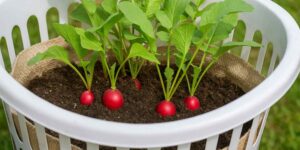Starting a kitchen garden is a rewarding hobby that offers fresh produce at your fingertips, saves money, and enhances well-being. If you’ve ever wanted to grow your herbs or vegetables but felt intimidated, this guide is designed for you. Following these simple steps, you can build a beautiful and productive kitchen garden – no green thumb required!

1. Choosing the Right Location
The location of your garden is crucial for plant health and productivity. Here’s what to consider:
- Sunlight: Most vegetables and herbs need at least 6-8 hours of sunlight daily. Look for a spot in your yard, balcony, or windowsill that gets ample sun.
- Space Availability: Your garden can be any size! Raised beds, pots, and vertical gardening options can all work in smaller spaces.
- Accessibility: If possible, choose a spot close to your kitchen. The convenience will encourage you to water and tend to it regularly.
Pro Tip: If you’re limited on sunlight, try growing herbs like parsley or mint, which can tolerate partial shade.
2. Gathering Essential Tools and Materials
A few basic tools will make your gardening experience easier and more enjoyable. Here’s a starter list:
- Hand Trowel: Ideal for planting, digging, and moving soil.
- Watering Can or Hose: Look for options with a gentle spray nozzle to avoid damaging delicate plants.
- Pruning Shears: Perfect for trimming plants and harvesting.
- Gardening Gloves: Essential for protecting your hands from dirt and sharp tools.
- Containers (if needed): Great for patios or balconies, making gardening manageable for beginners.
- Quality Soil and Compost: Good soil is key! Look for nutrient-rich soil, preferably with organic matter.
Having these tools on hand ensures you’re ready for each gardening stage without unnecessary hassle.
3. Selecting Suitable Plants
Not all plants are beginner-friendly, so it’s wise to start with easy-to-grow varieties. Here are some reliable options:
- Herbs: Basil, mint, parsley, and chives thrive indoors and outdoors.
- Vegetables: Start with lettuce, radishes, carrots, and cherry tomatoes; they’re relatively low-maintenance and grow quickly.
- Microgreens: Perfect for limited space, they grow in trays and can be harvested in as little as two weeks.
These plants are forgiving, grow quickly, and offer quick rewards, which is perfect for beginners eager to see results!
4. Preparing the Soil
Healthy soil is the backbone of a productive garden. Follow these steps to ensure it’s rich in nutrients:
- Loosen the Soil: Use a hand trowel or shovel to loosen it up, making it easier for roots to grow.
- Add Compost or Organic Matter: Enrich your soil by mixing in compost or organic fertilizer. This boosts nutrients and improves water retention.
- Check pH Levels (Optional): Most kitchen garden plants prefer slightly acidic to neutral soil (pH 6.0–7.0). If you’re curious, affordable pH test kits are available.
Preparing the soil before planting creates a nutrient-rich environment that helps your plants thrive.
5. Planting Seeds and Seedlings
Now for the exciting part – planting! Here’s how to do it right:
- Seeds: Follow the instructions on the seed packet for depth and spacing. Generally, seeds should be planted at a depth twice their size.
- Seedlings: If you’re planting young plants, dig a hole that accommodates the root ball comfortably and cover it with soil, pressing down gently.
- Spacing: Avoid overcrowding, as plants need room to grow. Check the recommended spacing for each type.
Pro Tip: Plant herbs closer to the edges of your garden or containers to make them more accessible for frequent harvesting.
6. Watering and Maintenance
Regular care is crucial for a thriving garden, and it’s easier than you might think:
- Watering Schedule: Most plants need consistent moisture, especially during early growth. Water deeply every 2–3 days, depending on the climate, allowing the soil to dry slightly between watering.
- Mulching: Adding a layer of mulch around plants helps retain moisture, prevents weeds, and keeps the soil cool.
- Weeding: Remove weeds regularly to reduce competition for nutrients.
Keeping a simple watering and maintenance routine ensures your plants stay healthy and productive.
7. Dealing with Pests and Diseases
Even with the best care, pests and diseases can sneak into your garden. Here’s how to handle them:
- Inspect Regularly: Check leaves for holes, spots, or pests. Addressing problems early can prevent bigger issues.
- Natural Remedies: For mild infestations, try neem oil, garlic spray, or soapy water to deter pests.
- Beneficial Insects: Encourage friendly insects like ladybugs and bees, which can help keep pest populations under control.
Learning to spot and address these issues is a valuable skill, and there are many resources on organic pest control if you need extra help.
8. Harvesting
Nothing is more satisfying than enjoying fresh produce straight from your garden! Here are some general guidelines:
- Timing: Many herbs can be harvested continuously as long as you don’t take more than one-third at a time. For vegetables, look for size and color cues (e.g., lettuce leaves or mature carrots).
- Technique: Use pruning shears or scissors to harvest cleanly without damaging the plant.
- Store Properly: Once harvested, store your produce in a cool, dry place or refrigerate for freshness.
Harvesting at the right time maximizes flavor and encourages further growth in your garden.
Starting a kitchen garden is easier than you might think – and the rewards are endless! With a little planning, regular care, and some basic know-how, you’ll be on your way to enjoying homegrown produce in no time. For more detailed information, there are plenty of online resources, local gardening clubs, and books to guide you further.
Happy gardening, and here’s to your first bountiful harvest! 🌱





